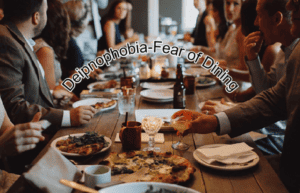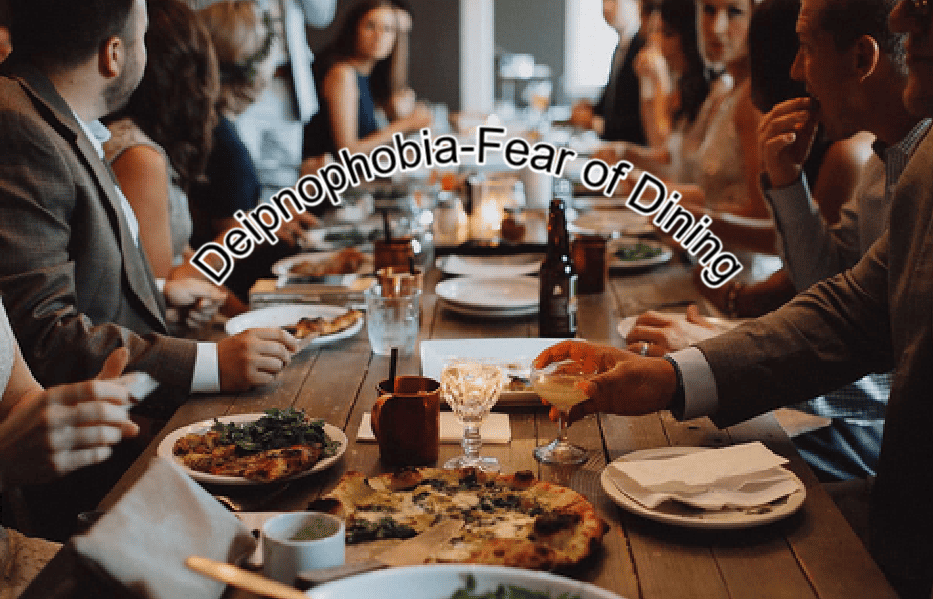Share This Article
Deipnophobia: Fear of Dining or Dinner Conversations
Food is a necessity and even a passion for some. Aside from acquiring nutrition for our bodies, it’s a way to bond and share experiences with others. However, a few of us suffer from a fear of social dining or mealtime conversations.
These individuals often prefer to eat alone because they feel more comfortable and safer that way. They might make excuses not to be part of a social dining event. Even a simple dinner with family and friends can trigger their mealtime phobia, which can negatively affect their social lives.
If your life is characterized by an extreme avoidance of social dining, you may fail to enjoy mealtimes like others. This could mean you have deipnophobia. But what exactly is this fear and how can you address it?

Symptoms of Deipnophobia
Your fear of group dining can manifest in many unique ways. The mere mention of having lunch together or attending an event with a group of people can trigger uncontrollable emotions. In severe cases, even looking at pictures of people eating together can cause panic.
The symptoms of this phobia vary from one person to another. The severity and how long each symptom lasts is also unique for each person. Most of the time, it manifests as physical or mental/emotional symptoms.
Physical Symptoms
- Chest pain or tightness
- Cold (or hot) flashes
- Difficulty breathing
- Dizziness
- Racing heart
- Trembling
- Sweating
- Upset stomach
Mental/Emotional Symptoms
- An urgent need to escape or be alone
- Feeling detached from yourself
- Loss of control
- Overwhelming apprehension
- Strong feelings of powerlessness
Causes of Deipnophobia
Like all phobias, deipnophobia doesn’t have any specific root cause. Oftentimes, this phobia develops due to negative and traumatic experiences that occurred during childhood or early adulthood.
For instance, while eating with family and friends as a child, you may have witnessed something terrible or something tragic happened while dining out.
Aside from traumatic events in the past, growing up with family and friends who have extreme anxiety or anti-social behaviors can also make you more susceptible to developing this phobia.
Treatment of Deipnophobia
Those who suffer from phobias are usually aware that something is off. This realization helps in the diagnosis and treatment of phobias like deipnophobia.
Phobias are treatable. Treatment options can be in the form of self-help options, professional therapy, or a combination of the two.
Self-Help Options for Deipnophobia
Here are some self-help options you can try.
#1. Take the Initiative to Learn About Your Phobia
Having a deeper understanding of your fear can empower you and eventually help you realize there’s nothing to be afraid of. Note down your thoughts and feelings in a journal and write down what it is exactly that’s making you feel scared. Finally, jot down your goal to be in better control of your phobia and the steps you need to take to achieve it.
#2. Make Some Lifestyle Changes
Making simple lifestyle adjustments can help you manage your phobia and reduce its symptoms. For instance, you can cut back on your caffeine intake, make sure to always get enough sleep, and engage in physical exercises.
#3. Learn Relaxation Techniques
Breathing exercises and activities that help you control your breathing are helpful when you’re about to have a panic attack. Exhaling the negativity out of your body and calming your mind can help you better react to your phobia.
Professional Treatments for Deipnophobia
Speaking to a medical professional such as a psychiatrist or psychologist is useful when you want to treat your phobia with a more structured approach. Based on the severity of your phobia as well as the assessment by your doctor, you may be encouraged to try one or several of these therapies:
#1. Desensitization Therapy
Also referred to as exposure therapy, these sessions aim to change your reaction to the situation you fear. You will be gradually exposed to your phobia in increments and always in a controlled environment. This is done regularly until you can better manage your panic triggers and react to them better.
#2. Cognitive Behavioral Therapy (CBT)
Cognitive behavioral therapy is almost always included in treating any form of phobia. The goal of these sessions is to help you determine the root cause of your anxiety. Eventually, CBT will help you replace your fears with more grounded and realistic thoughts. During your sessions, you’ll learn different coping techniques and alternative perspectives regarding your fear.
More often than not, CBT is paired with breathing techniques like meditation and yoga.
#3. Prescription Drugs
Your mental health professional may also prescribe medication to help you control your panic and anxiety. Note that medications are not usually the first course of action and are only given as needed. Beta-blockers, antidepressants, and sedatives are examples of commonly prescribed drugs.
Living with Deipnophobia
Deipnophobia is a type of social anxiety disorder that is complex and can negatively influence your social ties. After all, almost all social events involve food that is enjoyed together. This can lead you to miss out on important celebrations and daily events that are often important for forming healthy relationships. Lunches, anniversaries, birthdays, weddings, and more—life can get quite lonely if you can’t eat with other people.
But you don’t have to live with your phobia forever. You can overcome it and begin enjoying social dining experiences again. With patience, the right treatment, and a strong determination to get rid of deipnophobia, you can move past this chapter of your life and forge stronger social connections.
Conclusion
Enjoy food, enjoy the company of your friends, and enjoy life. Although it’s a tough battle, you can prevail. Deipnophobia might be overpowering you today but it doesn’t always have to be that way. As you can see, there are different therapies you can try. With self-help and professional guidance, you can learn to enjoy food and the people around you simultaneously.
Sources:
https://www.eatingdisorderhope.com/blog/deipnophobia-food-and-eating-anxiety-in-public
https://www.helpguide.org/articles/anxiety/phobias-and-irrational-fears.htm



